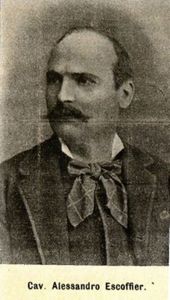Entrepreneur, Patriot and Mayor
 Alessandro Escoffier was born in Nice on 29 September 1843 to Francesco and Luigia Fornari.
Alessandro Escoffier was born in Nice on 29 September 1843 to Francesco and Luigia Fornari.
Belonging to a family of olive oil exporters (his father had founded in 1833 one of the most famous oil companies in Nice), after the transfer of Nice to France in 1860, he transferred the flourishing company inherited from his father to Sanremo in order to maintain his Italian citizenship. The young Alessandro then participated as a volunteer in the events of the Risorgimento in the ranks of Garibaldi, demonstrating considerable value. For his merits in the field of work he would also have been the first citizen in the province of Porto Maurizio, and the second in Liguria, to be awarded the Knight of Labour Cross.
After suspending his military activity, he decided to follow in his father's footsteps, dedicating himself to the oil trade; so he opened a small shop in a small hovel on the corner of Via Gaudio with Strada Nuova (now Via Matteotti), in front of Palazzo Borea d'Olmo, later demolished.
In 1886 he went to Calabria, where he had already worked as a soldier during the campaign against brigandage, starting a profitable activity aimed at improving the yield of the olive groves of Reggio, which were not very profitable due to the inadequate oil mills and the bad harvesting system. The initiative had an unexpected success and in a short time the entire olive production of the area recorded a consistent increase in quantity and quality. Its innovations were also applied in nearby Tunisia, where they would be exploited by some French industrialists.
In the meantime, his shop in Sanremo had given way to two buildings built on the same area, one with a façade facing upstream, the other facing the sea, on the side of Via Roma, while the company had acquired a great reputation for the initiatives and systems of its principal, who had already allocated a percentage of his company's profits to his employees after a certain period of apprenticeship. In those years he also married the daughter of the industrialist and town councillor Giacomo Guidi, Giovanna, from whom he had only one daughter, who later married the nephew of Siro Andrea Carli Paolo Assereto, who later became Podesta of Savona.
On 26 July 1891 he took on the role of mayor and immediately promoted a series of important public works. These included the widening of the stretch of road between Piazza Colombo and the church of Santa Maria degli Angeli, the plantation of magnolias along Via Roma, the construction of the last two trunks of the road to Verezzo, the renovation of the Turchine monastery, the enlargement of Piazza Nota, the construction of the main collector sewer at the San Romolo stream, the enlargement of the opera house at the Teatro Principe Amedeo, the renovation of some country roads, the completion of the pavement to the entrance to the road to Ceriana, the extension of the west pier by more than two hundred metres, the construction of new public fountains and the restoration of the main public monuments damaged by the 1887 earthquake.
During its administration, negotiations were also started with the provincial authorities for the opening of Corso Mazzini, in the eastern part of the city, and the urban police regulations were reformed according to the new legislative provisions. When his mandate ended, Escoffier would be replaced in October 1893 by Marquis Giambattista Borea d'Olmo. After the local elections of June 1895, which once again sanctioned the victory of the conservative exponents, he held the office of mayor for a second term from August to October 1995. He died in Sanremo on 1st January 1913 and his death aroused sincere emotion and deep regret on the part of the entire town.
In 1919 the Municipal Administration dedicated to him the road that links Portegu Sgarbu with Via Matteotti, once called Via Privata and later Via Corsica.
(source text Andrea Gandolfo)




